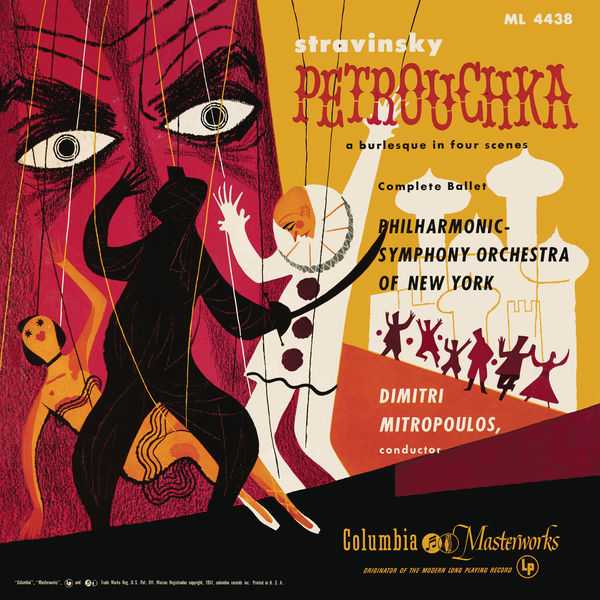Mitropoulos

Dimitri Mitropoulos is one of those conductors from the mid-20th century, like Hermann Abendroth, who was rediscovered as the century drew to a close. A renowned interpreter of the works of Mahler, Tchaikovsky, Mussorgsky, and other late Romantics, he was also one of the most controversial and tragic musical figures of his era, owing to his barely concealed homosexuality and his fanatical, almost priest-like dedication to music, which ultimately helped cost him his life.
Born in Athens at the end of the 19th century, he was a gifted music student from a very early age – at age five he carved a flute and learned to play it, and he later began formal piano lessons. By age ten, he’d begun writing his own compositions and playing them, and was spotted by a professor at the Athens Conservatory, who encouraged him to continue with his music. Mitropoulos was drawn equally to religion and music, and for a time considered life as a monk, and later as a priest in the Greek Orthodox Church, until he learned that in this role he would be permitted a bare minimum of music in his life. His formal musical training at the Athens Conservatory included composition as well as performance, and as a student, Mitropoulos performed several of his own pieces, and earned a prize in his fourth year of study as the highest graded student of counterpoint in the history of the conservatory. He later studied percussion, and while in the conservatory’s orchestra, when a conductor of uncertain beat was at the podium, Mitropoulos provided the beat himself. He spent much of his two years of military service as a member of an army band. It was as a pianist that Mitropoulos made his debut as an orchestral soloist, on d’Indy’s Symphony on a French Mountain Air in 1918. By this time he’d also conducted the conservatory orchestra several times, all successfully.
Mitropoulos studied in Berlin with Ferruccio Busoni before returning to Athens, where he made his name as a conductor. It was in those years that Mitropoulos’ work as a composer faded into the background – it was as an interpreter of other composers’ works that he would make his reputation to the world. He didn’t compose at all from 1931 through 1937, and in later years, amid all of his major appointments, seldom programmed his own works. During the ’30s, however, when he returned to Berlin as a promising conductor, Mitropoulos did perform some of his own works, as well as Prokofiev’s Third Piano Concerto, a work for which he truly became celebrated as a soloist and conductor. Ironically enough, Prokofiev resented Mitropoulos’ fame and facility with the concerto, for he had been earning handsome fees performing the piece himself in concert, until demand for Mitropoulos outstripped interest in his performances – after witnessing a performance by this new “competitor,” Prokofiev reportedly was resigned to having to write a new concerto for his own performance repertoire.
Mitropoulos’ American career began with an engagement with the Boston Symphony Orchestra in 1936 that took the musical world by storm. Not only were the reviews all exceedingly positive, but the members and management of the orchestra had only good to say about Mitropoulos. In 1937, Mitropoulos returned to America for a visit that included his first performance with the Minneapolis Symphony Orchestra. He also had an encounter in Boston with a music student named Leonard Bernstein – who, until then, had intended to become a pianist – that resulted in Bernstein’s deciding to pursue a career as a conductor. In 1938, in the wake of his electrifying debut with the Minneapolis Symphony, Mitropoulos was appointed music director of the orchestra. At the time, he succeeded such luminaries as Bruno Walter, Leopold Stokowski, and Eugene Ormandy, taking up a ten-year appointment that would have the orchestra making some of its most celebrated recordings as well as rising to the level of a top national orchestra. Mitropoulos’ tenure with the Minneapolis Symphony was different from his predecessors. He not only remained in the post far longer, but he had no other appointments to distract him even part of the year. Mitropoulos became a popular local figure, and took an active interest in the college and high-school level orchestras in the city, and had an influence that extended beyond classical music – at least one jazz drummer working in New York well into the mid-’90s credits Mitropoulos with having helped start him off as a percussionist with a high school orchestra in Minneapolis.
Mitropoulos’ work with the Minneapolis Symphony led to a resumption of the orchestra’s recording activities, which had ceased after Ormandy’s departure in 1936 – beginning in 1940, the orchestra’s recordings for the Columbia Masterworks label became a mainstay of the company’s catalog, in competition with the likes of the New York Philharmonic. These were also the first recordings of his career, the most notable of which was his debut, the Mahler Symphony No. 1, which was also the first recording of the symphony. Today considered a groundbreaking performance, at the time, Mitropoulos had to fight the orchestra’s board long and hard to get permission to record the Mahler symphony.
In 1949, Mitropoulos succeeded Artur Rodzinski as music director of the New York Philharmonic, perhaps the most visible conducting post in the United States. Seemingly at the pinnacle of his career in America, Mitropoulos for the first time ran into serious trouble in his conducting career at the podium of the New York Philharmonic. The New York directorship was a notoriously stressful job and had driven many talented men – most notably Sir John Barbirolli – to early resignations. The orchestra itself was one of the most difficult and recalcitrant in the world, with a membership whose arrogance and intractability was legendary. Moreover, the Philharmonic was a very different sort of orchestra in those days – it was not a full-time, year-round institution, its season lasting only five months out of the year, and the pay was relatively low. Additionally, the Philharmonic in those days had a competitor in New York that was even more visible to the general public, in the guise of the NBC Symphony Orchestra, a broadcast orchestra created for Arturo Toscanini, who remained – to the public at large – the dominant figure at the podium not only in New York but the entire United States, thanks to the NBC Symphony’s radio and television broadcasts. Additionally, the Philharmonic’s management frequently tried to manipulate its players and conductor, playing one off against the other.
Mitropoulos quickly found himself caught between those forces, and also on the receiving end of harsh attacks from the New York music critics for his programming and performances. His musical skills were considerable, but Mitropoulos was most comfortable working with late-19th century music – his Beethoven was suspect and his Mozart and Haydn awkward, bridging the gap between Classical and Romantic orchestration with great difficulty. He espoused modern music, a major prerequisite for the Philharmonic’s director, but his interest in this direction was primarily aimed at European works, rather than American composers – and the orchestra’s management and audience were more devoted to the latter. Mitropoulos’ recorded legacy was blighted to some degree by the short-sightedness of the Columbia Masterworks label, for which the Philharmonic recorded – he never had the time or budget for his recordings that the Philadelphia Orchestra under Eugene Ormandy (which, admittedly, sold better at the time) received, and there were major holes in his repertoire as represented on record, including only a single official recording (from 1940, no less) of any of the Mahler symphonies.
Despite some triumphant moments – a Mahler Symphony No. 3 (alas, only preserved in a grotesquely edited broadcast tape) from 1955 that marked the first performance of the piece in New York in over 20 years, and a Berlioz Symphony Fantastique that is still counted among the best recordings of the piece ever made – Mitropoulos’ tenure in New York was generally an unhappy one, marked by unfulfilled promise and oncoming health problems, including the development of a serious heart problem.
The orchestra was almost openly in rebellion against Mitropoulos on many nights, and by 1955 there were rumors that the management was courting Guido Cantelli, the young Italian conductor not much more than half Mitropoulos’ age, was being courted as a co-director and successor. These suggestions ended with Cantelli’s death early in 1956 in a plane crash, but didn’t end the idea that Mitropoulos would be replaced. It is also a matter of conjecture how much Mitropoulos’ homosexuality, coupled with his austere, monklike lifestyle, and even his ethnicity and nationality came into play. His sexual preference was known to members of the orchestra but never discussed openly; coupled with his austere, monkish lifestyle, however, it created stresses that only added to his problems with the orchestra and its management. Additionally, there was only so much that a Greek-born musician could do to elicit popular or financial support in New York City. Many of his performances did elicit positive responses from subscription audiences, but the management of the orchestra wanted a more photogenic, charismatic figure as music director, and even if they could no longer have Cantelli, they were going to have it. By 1956, it was clearly ending for Mitropoulos, as the Philharmonic was actively looking for a successor.
They found this in Leonard Bernstein. Ironically enough, Bernstein was also homosexual, but he had a marriage of convenience to protect his image and looked the part of a very dynamic, fiercely masculine sexual figure at the podium, attractive to women and suitably conventional in appearance to men. He was also considered the daring young Turk among American-born maestros, and the fact that he was Jewish – in a city where Jewish philanthropy made up a major part of the potential funding for the orchestra – didn’t hurt his prospects. Bernstein actively campaigned for the position, emphasizing his status as a married man with children, and finally took the music directorship from Mitropoulos. The announcement was made late in 1956, and Bernstein assumed a difficult co-conductorship before Mitropoulos was forced out altogether. Ironically, it was at the Metropolitan Opera, where Mitropoulos conducted such works as Alban Berg’s Wozzeck as well as much mainstream repertoire to unqualified praise, that his greatest New York triumphs lay.
Mitropoulos recorded with the Philharmonic into 1957 (including the Symphonie Fantastique), and made the rounds of the world’s orchestras as a guest conductor, reaping musical and critical praise wherever he went. He kept up a pace that was probably too much for his body, as though little of it mattered to him. On October 31, 1959, he conducted Mahler’s massive Symphony No. 3 with the Cologne Radio Orchestra (a performance that was taped and which has been released) and went to Milan to prepare a performance of the same work the next day. While rehearsing the symphony, he was stricken with a fatal heart attack and died at the podium.
Dimitri Mitropoulos began to be remembered at the end of the 20th century, principally on the strength of his recordings. His sexual preference – which can now be openly discussed – has made him something of a hero and martyr to the gay community, but beyond the social issues raised by his life, his musical legacy speaks ever louder. Ironically enough, for all of his espousal of Mahler’s music (all but one of the symphonies, including the massive Eighth, were in his repertoire), he only ever officially recorded the First Symphony, with the Minneapolis Symphony Orchestra – this performance, which has been available from the Italian pirate label Theorema, and more recently has been scheduled for official release from Sony Classical, is worth owning as a first recording of the piece, as an eloquent and beautifully realized performance, and a piece of seminal music-making in an area that was entirely new at the time. The Mahler Third from Cologne, and recordings of the Fifth, Sixth, and Eighth, preserved from various broadcasts, round out this part of his legacy.
More recently, there has been considerable unearthing of Mitropoulos performances from various official archival sources. A performance of Mozart’s Don Giovanni from the Salzburg Festival in 1956 and released in 1994, has taken its place as one of the most gripping and exciting records of the opera ever released. Additionally, the Rochester, NY-based collector’s label Nickson, run by archivist Nick Nickson, has released extraordinarily good-sounding CD versions of Mitropoulos’ Minneapolis recordings. Sony Classical, the successor label to Columbia Masterworks, has also planned a major compact disc reissue series devoted to Mitropoulos’ New York Philharmonic and Minneapolis Symphony recordings.











